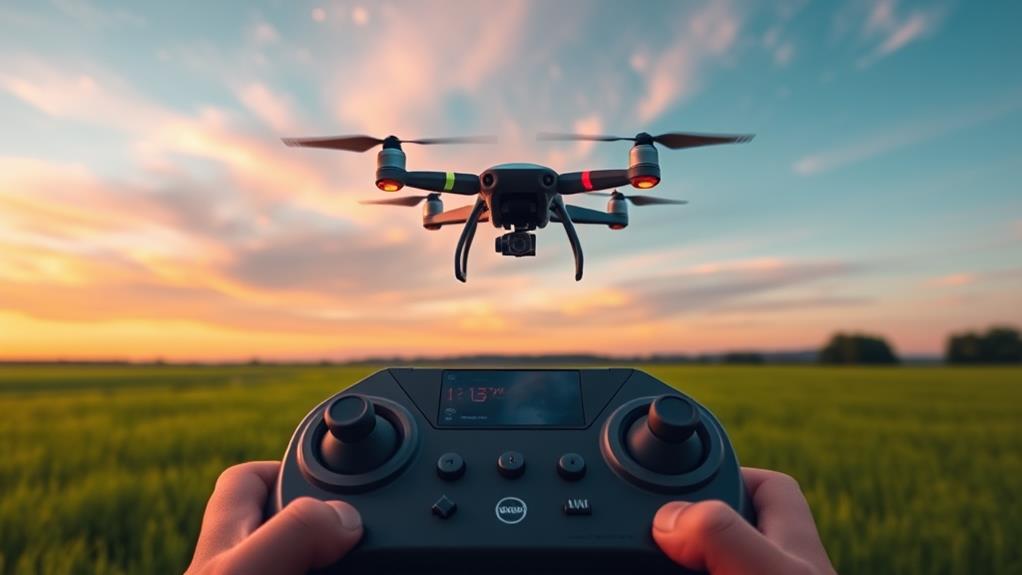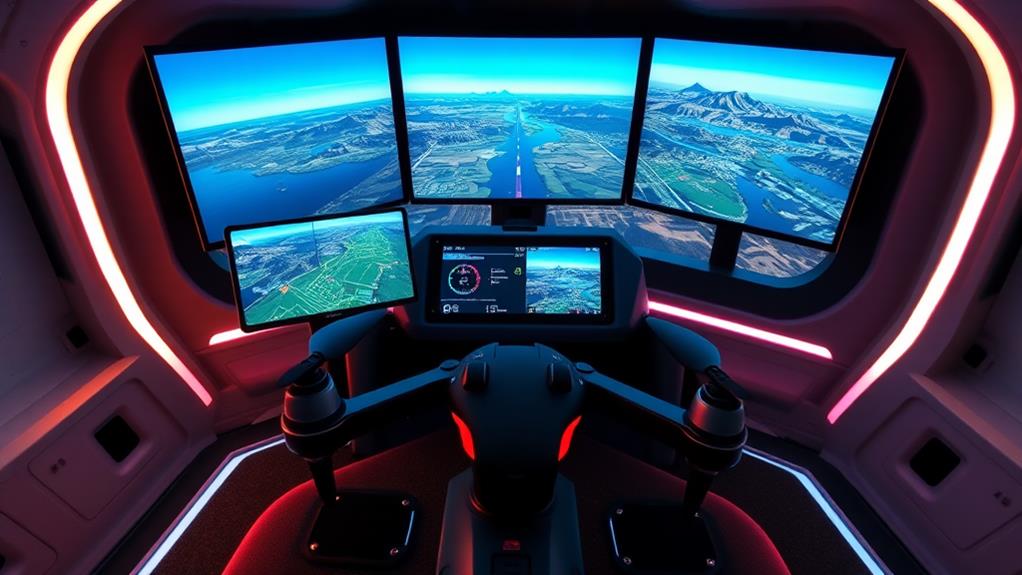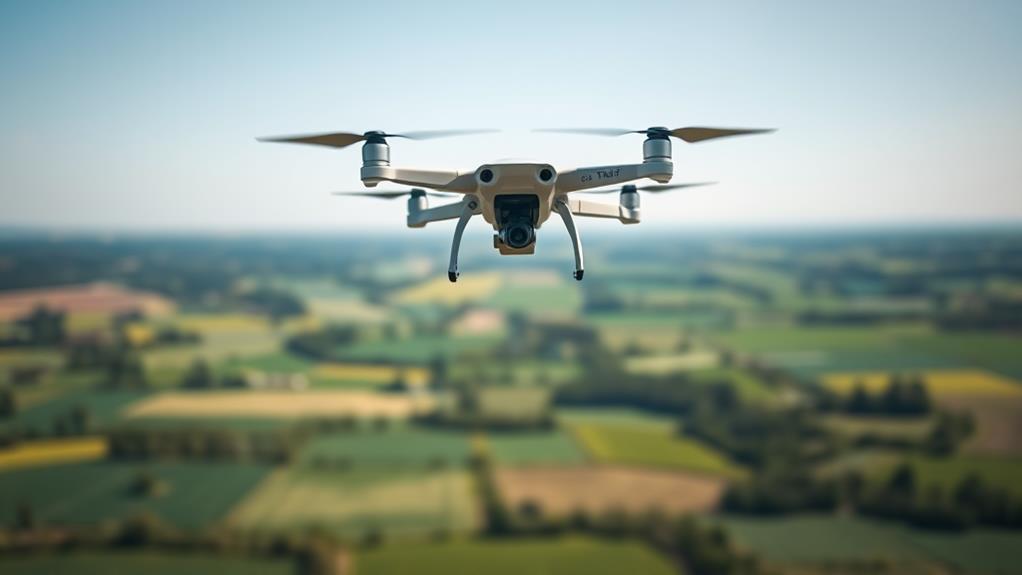To excel at drone flight control, start by mastering basic maneuvers like throttle, yaw, pitch, and roll. Thorough pre-flight checks are essential; inspect your drone, verify battery life, and confirm GPS calibration. Pay attention to environmental factors—avoid strong winds and bad weather that can jeopardize control. Engage in continuous learning through workshops, courses, and practice, building critical muscle memory. Finally, utilize simulation tools for safe practice, enabling you to refine your skills in various scenarios. Implementing these strategies will greatly improve your flying capabilities, paving the way for more advanced techniques and experiences.
Mastering Basic Flight Controls

Mastering the basic flight controls is essential if you want to become a confident drone pilot. Understanding the four main controls—throttle, yaw, pitch, and roll—will greatly enhance your drone flying skills. The throttle adjusts your altitude, while yaw rotates your drone left or right. Pitch tilts your drone forward or backward, and roll tilts it side to side. Grasping these controls helps you navigate potential risks during flight.
Practicing basic maneuvers like take-off, landing, and hovering is key to building your coordination. Engage in exercises such as flying in square and circular patterns to improve your spatial awareness. These skills not only boost your confidence but also refine your reaction times.
Familiarizing yourself with different flight modes, like GPS for stability and manual for control, adapts your flying to various conditions.
Importance of Pre-Flight Checks
Before you take to the skies with your drone, performing pre-flight checks is non-negotiable for a safe and successful flight. As a drone pilot, you must verify your aircraft's structural integrity. Inspect the rotors, cables, and mounted equipment for any visible damage or wear. A thorough check can prevent accidents caused by malfunctioning parts.
It's vital to confirm that your drone's battery is fully charged and that all connections are secure. This step considerably enhances flight time and control, reducing the risk of mid-flight power failures.
Establishing a pre-flight checklist is also beneficial; include weather assessments and airspace research to comply with local regulations and boost overall safety.
Don't forget to check the functionality of your drone's systems. GPS calibration and compass accuracy are essential for maintaining precise navigation, helping prevent disorientation during flying.
Understanding Environmental Factors

Understanding environmental factors is essential for successful drone flight. Before flying your drone, you need to be aware of how weather conditions can impact performance.
Using apps like SkyWatch.AI can help you monitor wind speed, precipitation, and visibility, ensuring safety and stability. For most consumer drones, avoid flying in winds over 20 mph, as strong gusts can exceed your drone's design limits and lead to loss of control.
Temperature also plays a vital role; colder weather can reduce battery efficiency, affecting your drone's performance. Always check battery health before flights in chilly conditions to prevent unexpected issues.
Terrain can introduce obstacles that may compromise public safety, especially in densely populated areas. Make sure to analyze your surroundings and avoid flying near trees or buildings to prevent collisions.
Continuous Learning and Practice
Continuous learning and practice are essential for anyone looking to excel in drone flight control. Engaging in ongoing education, like taking courses or attending workshops, helps you stay updated on the latest flying techniques and technology advancements. With the ever-evolving drone options available, it's imperative to keep refining your skills.
Practicing fundamental skills, such as throttle management and spatial awareness, enhances your coordination and reaction times, which are necessary for effective flight control. Regular practice helps you build muscle memory, making it easier to handle a professional drone with confidence.
Joining drone pilot communities not only allows you to share experiences but also fosters continuous learning through collective knowledge. You can gain valuable tips from fellow pilots, helping you improve your technique.
Additionally, reviewing flight logs and analyzing performance data can inform you about areas needing improvement. This self-assessment is essential for refining your flying techniques over time.
Utilizing Simulation Tools

Simulation tools are invaluable for mastering drone flight control, offering a risk-free environment to practice essential maneuvers. By using these tools, you can refine your flight maneuvers without the worry of damaging expensive equipment.
Many flight simulators provide realistic physics and environmental conditions, which help you develop spatial awareness and control under various scenarios. Additionally, some simulators come with customizable settings that allow you to practice specific maneuvers, like figure eights or precision landings, tailored to your skill level.
Engaging with simulated flight scenarios enhances your muscle memory and reaction times, making real-world flying feel more intuitive and controlled. Moreover, these tools offer opportunities to experiment with advanced techniques, such as waypoint navigation and automated flight paths, which you can apply during actual flights.
Conclusion
By honing your flight control skills, you're setting yourself up for success in the exciting world of drone piloting. Think of each flight as a stepping stone on a path that leads to mastery. Remember to prioritize pre-flight checks, stay aware of environmental factors, and embrace continuous learning. With the right practice and tools, you'll navigate the skies with precision and confidence. So, gear up and take flight—your journey is just beginning!

Leave a Reply